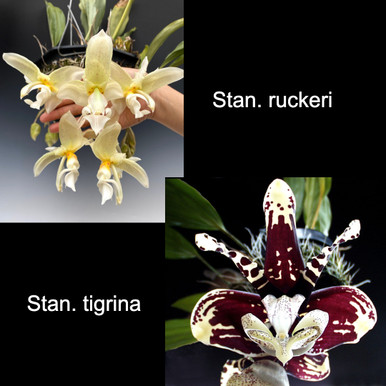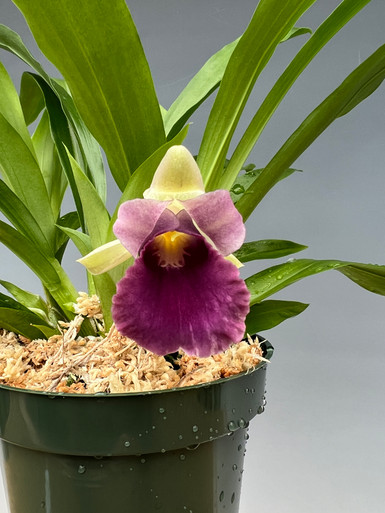Bulbophyllum Orchid Care
Although considered the largest group of orchids, there are general guidelines that can be followed when it comes to Bulbophyllum. These orchids are typically small to medium sized, although species like Bulb. phalaenopsis have leaves up to a meter long. They grow as creeping epiphytes, having a sympodial growth habit with one or two fleshy leaves emerging from prominent pseudobulbs. While there is a wide range of fantastic flower shapes and sizes, all Bulbophyllum have a hinged lip that aids in pollination. The pollinator lands on the lip, which tilts and causes the pollinator to fall back into the sticky pollina. Bulbophyllum are also known for having many species that produce foul, carrion-scented flowers.
Light and Shade
Bulbophyllum do well in shaded light (1000 to 1500 foot-candles), so that if a hand is passed over the leaves it does not produce a shadow. We recommend growing in east or north-facing windows, where they would receive diffuse light. South-facing windows should only be used if shielded from the sun using a sheer curtain. If using artificial light to grow indoors, LEDs are the best option for orchids. Bulbophyllum do well with 11 hours of artificial light in winter, and 14 to 16 hours in summer. The artificial light market has expanded greatly in recent years, so a quick Google search will result in a variety of lighting options and price ranges.
Temperature and Humidity
Bulbophyllum grow best with a day temperature range between 70°F and 80°F (20°C to 27°C). At night there should be at least a 10°F (6°C) drop, to around 60°F to 64°F (15°C to 18°C). This lower night temperature will help initiate flower buds and promote stronger growth. Be sure to keep the temperature no lower than 60°F (15°C), as these tropical-growing orchids do poorly in cooler temperatures. Bulbophyllum benefit from humidity levels 50% or higher. This can be achieved at home with the use of a humidifier or a humidity tray. Just make sure that the plant is not standing in water or the roots will rot.
Watering
Watered as the potting medium approaches dryness, but do not allow it to dry completely between waterings. Make sure to water more often when Bulbophyllum are about to bloom, and throughout the blooming period. When repotting your Bulbophyllum during the active growing season, do not water the media for at least 3 days. This allows cuts and breaks in the roots to callous and avoid rotting upon being watered. We always recommend watering in the morning, as this gives the leaves time to dry and avoid bacterial growth overnight. If possible, use water low in alkalinity, such as rainwater, distilled water, or reverse osmosis water. If you have a dehumidifier in your home, the water that collects in the tray is excellent for watering orchids.
Feeding
We highly recommend Green Jungle Orchid Food, specially formulated to provide orchids with the nutrients they would naturally encounter in their wild habitats. This is the fertilizer that we developed to use on our own plants in production, with excellent results for decades! This formula works best with water low in alkalinity (such as rainwater, distilled water, or reverse osmosis water). However, you may use tap water, keeping in mind that mineral buildup will require repotting more frequently, on the order of every 1 to 2 years. If potting in bark mix, fertilize every time you water during the growing season, flushing with non-softened water once a month. This rinses the media of salt and mineral buildup. During periods of inactive growth, fertilize every other watering. If potting in sphagnum moss, fertilize every 3rd watering year round.
Potting
At Orchids Limited, we recommend potting Bulbophyllum using New Zealand Sphagnum Moss or the Medium grade of our Traditional Orchid Bark Mix. Large Bulbophyllum specimens can utilize the Large grade of our Traditional Orchid Bark Mix. In general, repotting should be done every 2 years in the spring. Repotting becomes necessary when the plant has outgrown its pot and the new growth reaches out over the edge, or when the potting medium has broken down. When repotting, choose a pot that is large enough to accommodate 2 or 3 years growth (1 or 2 new pseudobulbs per year). When repotting, position the plant with its oldest pseudobulbs to the edge of the new pot. Then, spreading the plant roots out, fill in the space with the potting medium.
To avoid the transfer of orchid diseases, it is standard procedure to sterilize all cutting and potting instruments before using them on a plant. This can be done by flaming pruning shears with a butane torch, or by spraying with rubbing alcohol and wiping with a clean paper towel.
Pest Control
The main Bulbophyllum pests are mealybug, which will hide on the undersides of the leaves. The best treatment for mealybug is a homemade pesticide of 1:1 parts water & rubbing alcohol, with a few drops of dish soap added. Spray the plants every few days, washing off the dead bugs in between. For large outbreaks, an application of a specially formulated pesticide spray every few days is more effective.
Featured Products
Shop all →





